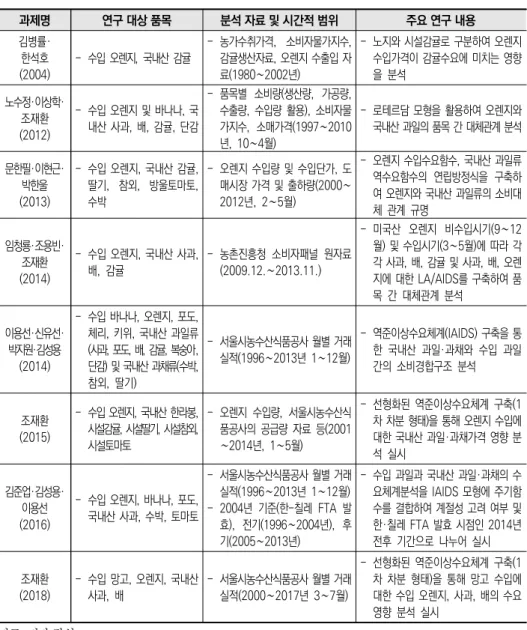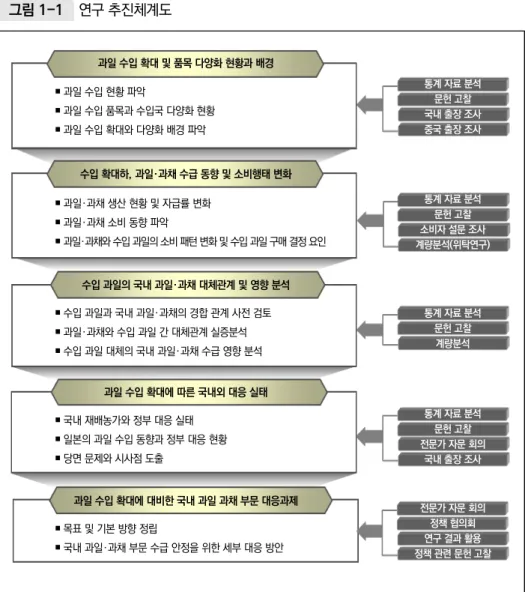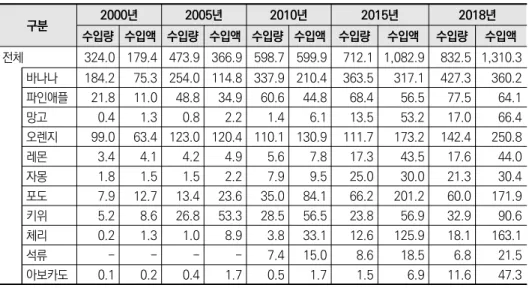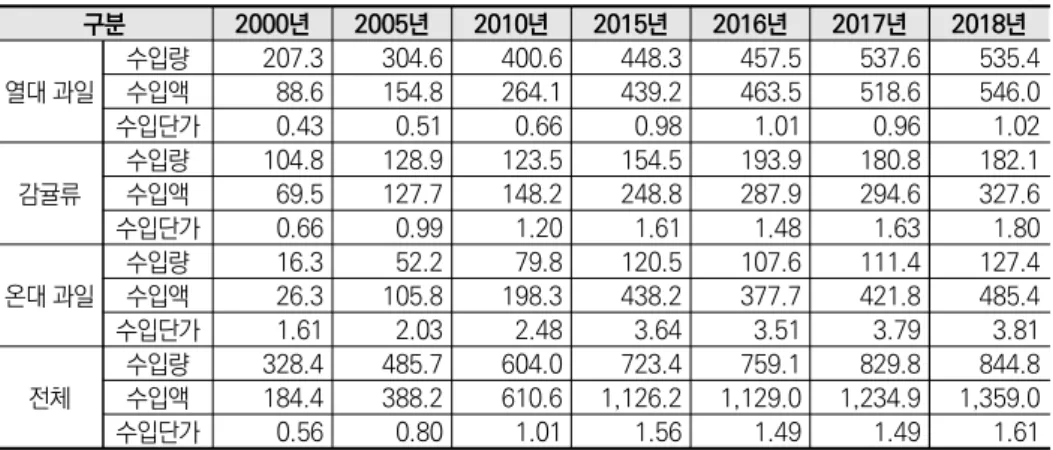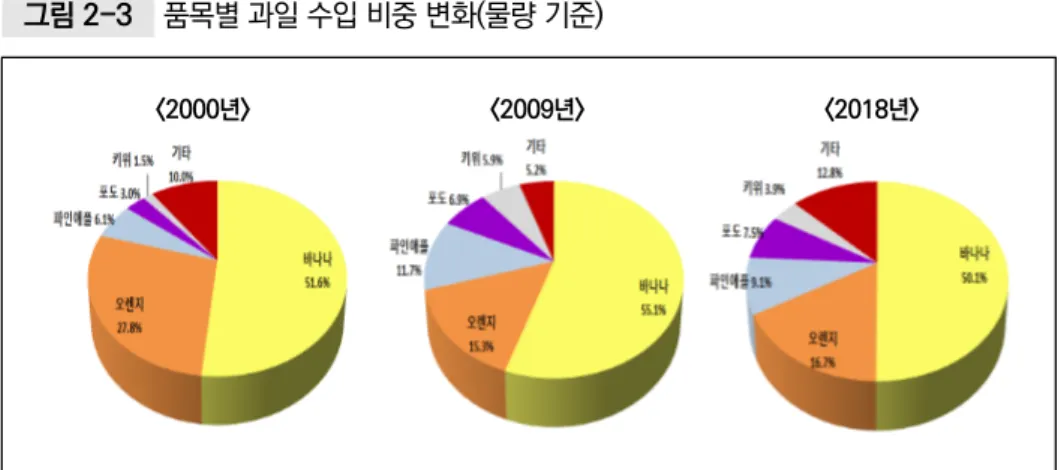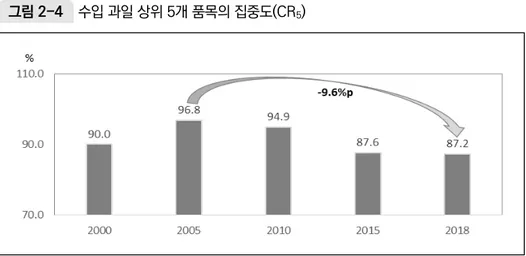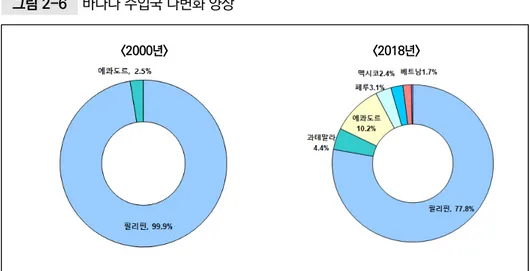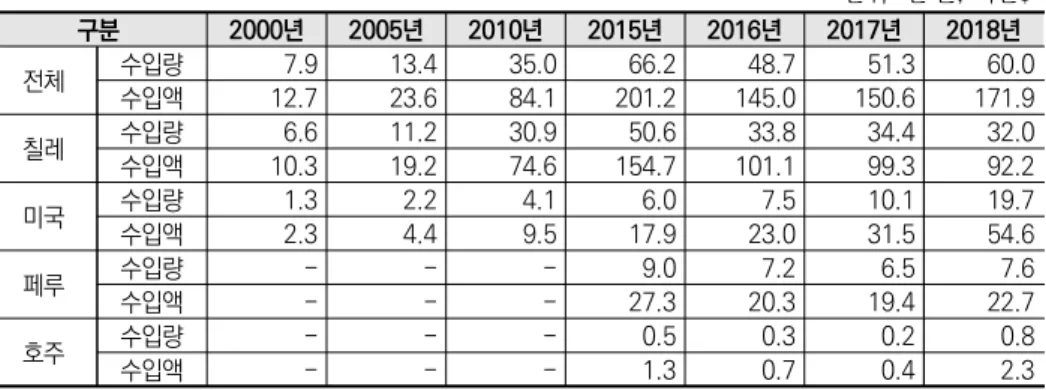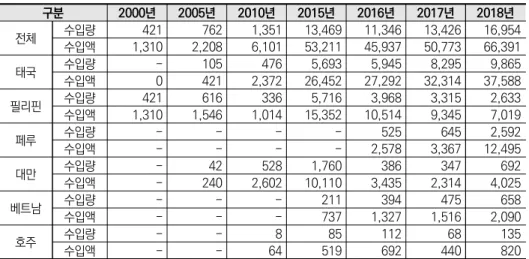www.krei.re.kr 2019년 한국농촌경제연구원 기본연구보고서 R868 공공급식 식재료 공급 실태와 개선과제 R869 글로벌시대 농산물 물류 및 상품 표준화 실태와 과제 R870 남북한 경협 재개 국면의 농업교류협력 구상과 추진 방안 R871 농업 분야 북방경제협력 활성화를 위한 민간투자 촉진 방안 R872 농업여건 변화에 대응한 농업보험정책 발전 방안 R873 농촌 활성화를 위한 창조계층 활용 방안 R874 농촌지역 저소득가구의 아동복지 실태와 정책과제 R875 보호무역주의 확산에 따른 농식품 통상분쟁 실태와 정책과제 R876 산림자원 순환경제 기반 마련을 위한 산림관리 효율화 방향 R877 산림휴양인프라 수급 실태와 정책과제 R878 수입 과일 품목 다양화에 따른 과일·과채 부문 영향 분석과 대응과제 R879 식품산업의 푸드테크 적용 실태와 과제 - 대체축산식품과 3D 식품 프린팅을 중심으로 R880 신선편이 과일·채소 시장 변화와 대응과제 R881 이상기후가 농업부문에 미치는 경제적 영향 분석 R882 저밀도 경제 기반의 농촌산업 활성화 방안 R883 지방자치단체의 농가 소득지원 실태와 정책과제 R884 지역 푸드플랜 실태와 정책과제 R885 토지공개념에 기초한 농지관리 제도 개선 방안 R886 포용성장을 위한 농업인 경영이양 지원 방안 R887 해외 곡물 도입 정책 진단과 개선 방안 R888 환경서비스를 고려한 효율적 농지자원 관리 방안 R889 농림업 분야 중점 협력국별 국제개발협력 전략 수립(2차년도) : 종합보고서 R890 농업·농촌 정책 고도화를 위한 정보지원체계 구축 방안 (2/5차년도) R891 농업구조 변화 전망과 대응과제(1/2차년도) R892 농업 혁신성장을 위한 농업기술 및 혁신성과 확산체계 개선 방안(1/2차년도) R893 미래 국토 전망과 농촌의 계획적 정비방안 연구(3/3차년도) R894 제4차산업혁명 시대의 농업·농촌 대응전략 연구(2/2차년도) R895 지방분권을 위한 농정 추진 체제 개편 방안(2/3차년도) R896 축산업의 사회적 책임 이행 실태와 정책과제(2/2차년도)
수입
과일
품목
다양화에
따른
과일
· 과채
부문
영향
분석과
대응과제
수입 과일 품목 다양화에 따른 과일·과채 부문 영향 분석과 대응과제Analysis of impacts on indigenous Fruits and Fruits-Vegetables Sector from diversified fruit imports and issues to cope with
R 878 2019
수입 과일 품목 다양화에
따른 과일·과채 부문 영향
분석과 대응과제
Analysis of impacts on indigenous Fruits and Fruits-Vegetables Sector from diversified fruit imports and issues to cope with
윤종열 박기환 박한울 R 878 l 2019. 10. l | 연구책임자 | 윤종열 jyyoon0712@krei.re.kr 한국농촌경제연구원 부연구위원 미주리대학교 농업경제학 박사 | 연구참여자 | 박기환 kihwan@krei.re.kr 한국농촌경제연구원 선임연구위원 교토대학교 농업경제학 박사
R 878 | 2019. 10. |
수입 과일 품목 다양화에
따른 과일·과채 부문 영향
분석과 대응과제
Analysis of impacts on indigenous Fruits and Fruits-Vegetables Sector from diversified fruit imports and issues to cope with연구 담당 윤종열︱부연구위원︱연구 총괄, 대체관계 및 파급영향 분석, 대응과제 도출 박기환︱선임연구위원︱일본 사례 및 대응과제 도출 박한울︱전문연구원︱자료 수집 및 통계 분석 연구보고 R878 수입 과일 품목 다양화에 따른 과일·과채 부문 영향 분석과 대응과제 등 록︱제6-0007호(1979. 5. 25.) 발 행︱2019. 10. 발 행 인︱김홍상 발 행 처︱한국농촌경제연구원 우) 58321 전라남도 나주시 빛가람로 601 대표전화 1833-5500 인 쇄 처︱크리커뮤니케이션 I S B N︱979-11-6149-324-4 93520 ∙ 이 책에 실린 내용은 출처를 명시하면 자유롭게 인용할 수 있습니다. 무단 전재하거나 복사하면 법에 저촉됩니다.
과일 수입은 WTO·FTA 체결 등 시장개방폭 증가로 급격히 증가하고 있으며, 수입되는 과일 품목도 점차 다양화됨으로써 국내 과일·과채류와의 소비 경쟁 심 화가 불가피해졌다. 더욱이 식생활의 서구화와 해외여행 경험 증가, 소비자 선호 도 변화 등으로 인해 수입 과일에 대한 소비자 수용도 또한 과거보다 크게 높아지 고 있다. 이 때문에 국내 과일·과채류 생산은 위축되고 있으며, 자급률 하락은 물 론, 국내산 소비량이 매년 감소하고 있어 향후 생산기반 유지에 대한 우려가 큰 실 정이다. 이러한 상황 속에서도 수입 과일에 비해 상대적으로 안전한 국내산 과일·과채 류의 안정적 공급을 원하는 소비자 욕구는 확대되는 추세이므로 이에 부응하기 위 한 대응책 마련이 필요한 시점이다. 따라서 이 연구는 수입 과일의 확대 이후 국내 과일·과채의 수급 동향 및 소비패턴 변화를 파악하고, 수입 과일과 국내 과일·과채 와의 대체관계를 명확히 규명하여 그 파급 영향을 분석한 후, 이를 기초로 국내산 수급 안정을 도모하기 위한 대응 전략을 마련하고자 수행되었다. 연구를 위해 아낌없는 조언을 해주신 자문위원들은 물론, 설문조사에 적극 협조 해 주신 소비자분들과 농촌진흥청, 농협, 농업기술센터 등의 외부 전문가분들, 도 매시장 청과법인 및 과일 수입업체 관계자분들, 방대한 시장 거래실적 자료를 기꺼 이 제공해주신 서울시농수산식품공사 실무자분들에게도 감사를 드린다. 아무쪼록 이 연구결과가 시장개방폭 확대의 파고 속에서 정부의 과일·과채 부문 대책 수립에 유용한 자료로 활용되어 우리나라 과일·과채산업이 지속적으로 발전할 수 있는 토 대가 되기를 진심으로 기대한다. 2019. 10. 한국농촌경제연구원장 김 홍 상
머리말
연구 배경과 목적 ○ 1990년대 농산물 개방 이후 FTA 체결 확대에 따른 시장개방 수준 확대로 과일 수입량이 급증하기 시작하였다. 최근에는 수입 과일의 양적 확대뿐만 아니라 수입 과일의 품목 다양화가 크게 진전되었고, 과일 수입선도 다변화 되는 추세이다. 이러한 여건 속에서 국내 과일·과채는 연중 다양한 수입 과 일과 출하 시기가 중복되어 소비 경합이 불가피한 상황이다. 맛과 기능성이 우수한 수입 과일의 소비 확대, 수입 과일에 대한 소비자의 친밀도 향상 등 으로 인해 수입 과일에 대한 소비자의 선호 경향도 높아지고 있다. 수입 과 일 확대 및 품목 다양화로 국내 과일 자급률은 지속적으로 하락하고 있고, 국내 과일·과채의 생산기반 위축과 소비 둔화 문제에 직면하고 있다. ○ 향후 FTA 체결 확대, WTO 농업협상 내 개도국 지위 전환에 따른 농산물 통상 환경변화로 국내 과일 시장개방폭은 현재보다 확대될 가능성이 크 고, 이로 인해 과일 수입 확대와 품목 다양화는 더욱 진전될 가능성이 있다. 수입 과일 증대 및 품목 다양화에 따른 국내 과일·과채의 수급 불안정 상황 을 극복할 수 있도록 정책적 논의가 필요한 시점이다. ○ 이 연구에서는 과일 수입과 국내 과일·과채 생산의 전반적인 실태를 파악· 평가하고, 과일에 대한 소비자의 선호와 구매행태에 어떠한 변화가 있는 지 조사·분석하고자 한다. 수입 과일 품목이 다양화되면서 국내산 과일·과 채와 대체관계에 있는 수입 과일을 식별하고 소비 대체관계가 깊은 수입 과일의 국내 유입 증가가 국내 과일·과채 수급에 어떤 영향을 미치는지 계
요 약
측하고자 한다. 이러한 분석 결과를 종합하여 국내 과일·과채의 안정적인 생산기반 유지 및 소비 확대를 위한 대응 방안을 제시하는 것이 이 연구의 목적이다. 연구 방법 ○ 과일 수입 확대 및 품목 다양화 현황, 수입 과일 품목 다양화 지표 분석, 국 내 과일·과채 수급 현황 분석은 한국무역협회 수출입 자료, 농림업 주요통 계 등 품목별 수급 기초 통계자료 분석 및 문헌 조사를 통해 이루어졌다. 수 입 과일 관련 데이터는 KATI 농식품 수출정보와 Global Trade Atlas 자료 를 활용하였다. 국내 과일·과채 생산 및 소비 실태 관련 분석에서는 농림축 산식품부의 주요 통계자료와 통계청 KOSIS 데이터를 이용하였다. ○ 계량 분석 방법론, 국내외 수입 과일 거래실태 및 여건 변화, 국내 과일·과 채와 아열대 과수 재배실태 및 문제점 등을 파악하기 위해 외부 전문가 협 의회, 유관기관 방문 조사 및 농가 면담 조사를 실시하였다. 국내 과일·과 채의 수급 안정을 위한 생산 및 소비 부문 정책과제 도출을 위해 농협, 지자 체, 농촌진흥청 등의 외부 전문가와 자문회의를 개최하여 의견을 수렴하 였다. ○ 수입 과일과 국내산 과일·과채 구매행태를 파악하기 위해 1인 가구 및 기 혼 여성 1,000명을 대상으로 설문 조사를 실시하였다. 수입 과일의 소비 선 호와 구매행태에 영향을 미치는 경제적·인구 사회적 요인 분석을 위해 외 부 전문가에게 원고를 위탁하였다.
주요 연구 결과 ○ 수입 과일과 국내 과일·과채 간 대체관계 분석은 우선 사전 검토를 위해 19 년간(2000~2018년) 도매시장 월별 거래자료를 이용해 국내 과일·과채와 수입 과일 간 출하 시기 중복 여부를 진단하였다. 대체관계 실증분석은 선 형화된 역준이상수요체계(LA/IAIDS)를 구축하여 실시하였다. 수입 과일 대체의 국내 과일·과채 수급 영향 분석은 계량 경제학적 연립방정식 체계 로 구성된 과일·과채 부분균형 모형을 구축하여 실시하였다. ○ 수입 과일 확대에 따른 해외 대응 사례 검토를 위해 일본의 과일 수입현황 통계자료와 과수 산업정책 관련 문헌 자료를 직접 수집·번역하여 정리하 였다. 이외에 중국 출장을 통해 중국 과일 수입실태, 수입 과일 도매시장 출 하 및 유통실태, 수입 과일 현지 시장 개척 동향 등을 파악하였다. ▶ 과일 수입 확대 및 품목 다양화 현황과 배경 ○ 우리나라 과일 수입량은 2000년 이후 연평균 5.4%, 수입액은 11.8%의 증가 추세에 있다. 과일 수입 확대는 UR·WTO·FTA 등 농산물 시장개방폭 지속 확대, 다양한 품목 및 소득 증대에 따른 기능성과일 선호 증가 등 소비자 소비 패턴 변화, 해외여행 증가로 인한 수입 과일 섭취기회 확대 등에 기인한다. ○ 과일 수입 확대와 더불어 최근 수입 과일 품목 다양화가 진전되고 있다. 수 입 과일 품목 수는 2000년에 레몬, 바나나, 석류, 오렌지, 자몽, 체리, 키위, 파인애플, 포도 등 9개 품목에 불과했으나, 최근에는 석류, 두리안, 파파야, 용과, 망고 등 다양한 온대·아열대 과일을 포함한 18개 품목이 수입되고 있
다. 수입 과일 상위 5개 품목의 수입집중도(CR5)는 2005년 이후 지속적인 감소세에 있으나, 주요 수입 과일 다양화 품목의 경우, 2018년 수입 비중이 전체의 10.3%로 2005년 대비 9.3%p 확대되었다. 지니계수와 타일 지수를 활용하여 계측한 결과에서도 두 계수 모두 최근에 올수록 추세적인 하락세 를 나타내고 있어 국내 과일 수입은 품목 다양화가 진전되는 것으로 해석 할 수 있다. ○ 수입 과일의 수입선 발굴 및 품종 다양화 등의 영향으로 최근 국내 수입 과 일의 원산지도 다변화되는 추세에 있다. 국내 과일 주요 수입국은 미국 (44.6%), 필리핀(18.2%), 칠레(8.9%)가 대표적인데, 최근에는 수입 과일 품목에 따라 중남미 국가(과테말라, 에콰도르, 페루 등) 등 여러 국가로부 터 과일이 수입되고 있다. ▶ 수입 확대하, 과일·과채 수급 동향 및 소비행태 변화 ○ 국내 주요 과일 재배면적은 연평균 1.9%, 생산량은 면적 감소로 1.3% 감소 추세에 있다. 국내 주요 과채류 재배면적과 생산량도 연평균 각각 2.0%, 1.3%의 감소 추세에 있다. 과일 공급량에서 수입 과일이 차지하는 비중 확 대로 국내 과일 자급률은 2000년 이후 지속적으로 감소하고 있다. 과채의 경우, 식물검역제도로 인해 신선형태로 수입이 이루어지지 않아 자급률은 100% 수준이나, 주 출하 시기가 대부분의 수입 과일 출하 시기와 중복되어 소비 경합이 예상된다. ○ 국내 과일 1인당 소비량은 2009년 이후 감소하여 최근 60kg 내외에서 정
체되었고, 과채류는 2005년 이후 감소하여 최근 40kg 초반까지 낮아졌다. 반면, 수입 과일의 1인당 소비량은 바나나, 오렌지를 제외하면 국내 과일· 과채에 비해 적은 수준이나 지속적인 증가세에 있다. ○ 국내 과일·과채와 수입 과일에 대한 소비자의 구매패턴 변화에 대한 주요 분석 결과는 다음과 같다. 과일·과채 구매행태의 경우, 구입 시 고려하는 사항으로 맛/당도의 비중이 감소하였으나, 여전히 가장 높은 항목인 것으 로 조사되었다. 소비자가 선호하는 포장규격은 낱개에서 소량 포장 중심 으로 변화했으며, 소비자가 구입 시 가장 큰 불만 사항은 시기와 관계없이 맛이 없다는 것을 지적하였다. 수입 과일 구매행태의 경우, 소비자의 수입 과일 구매 경험은 최근 들어 더욱 증대되었고, 소비자의 선호 수입 과일 품 목 변화, 선호 품목 다양화가 뚜렷하게 나타났다. 국내 과일·과채의 대체가 능 품목으로 소비자는 오렌지를 가장 선호하였고, 새로운 수입 과일 품목 유통 시 안전성이 확보되면 소비자의 절반 이상이 수입 과일을 구매할 의 향이 있는 것으로 조사되었다. 수입 과일 구매 결정요인 분석 결과, 수입 과 일에 대한 구매 경험과 품종 인지도는 수입 과일 구매에 긍정적인 효과를 주는 주요 요인으로 나타났다. ▶ 수입 과일의 국내 과일·과채 대체관계 및 영향 분석 ○ 월별 거래실적 비교를 통한 수입 과일과 국내 과일·과채 간 경합 관계 사전 검토 결과, 국내 과일·과채는 연중 고르게 수입되는 바나나, 파인애플, 자 몽뿐만 아니라 특정 시기에 수입이 집중되는 망고, 키위, 체리, 수입 포도 등과도 상당 부분 출하 시기가 겹치는 것으로 나타났다.
국내 과일·과채와 수입 과일 간 품목별 대체관계 실증분석 결과 부류 품목 그룹 수입 과일에 의한 국내 과일·과채 대체관계 국내 보조 그룹 1 사과 · 바나나(-1.4%), 파인애플(-0.3%), 키위(-0.2%), 자몽(-0.2%) 그룹 2 배 · 바나나(-1.6%), 파인애플(-0.3%), 키위(-0.2%), 자몽(-0.01%) 그룹 3 온주 감귤 · 바나나(-1.2%), 파인애플(-0.3%), 오렌지(-0.1%), 수입 포도(-0.3%), 망고(-0.04%) 그룹 4 만감류 · 바나나, 파인애플, 오렌지, 수입 포도, 망고 ‘음(-)’의 부호이나, 통계적인 유의성 없음. 그룹 5 포도 · 바나나(-0.6%), 파인애플(-0.1%), 수입 포도(-0.5%), 키위(-0.1%) 그룹 6 복숭아 · 바나나, 파인애플, 키위, 체리 모두 ‘양(+)’의 부호로 대체관계 미식별 주: ( )는 수입 과일 10% 공급량 증가에 따른 그룹별 국내 과일·과채 품목의 가격 하락률을 나타내며, 통계학 적으로 유의미한 결과임. 자료: 저자 작성. ○ 역수요함수체계 분석을 통한 국내 과일·과채와 수입 과일 간의 대체관계 실증분석 결과(품목 그룹 1∼11), 일부 품목을 제외한 대부분의 국내 과일· 과채는 품목 그룹에 속한 수입 과일과 경제학적으로 유의미한 대체관계가 존재하는 것으로 분석되었다. ○ 과일·과채 부분균형모형 추정을 통한 시나리오별 파급영향 분석 결과, 과 일 수입량 확대는 중장기적으로 국내 과일·과채 재배면적을 감소시키는 것으로 나타났다. 시나리오 1(전체 수입량 기준 연평균 증가율 일괄 적용) 과 시나리오 2(전통 수입 과일과 수입 과일 다양화 품목 수입량 기준 가중 평균 증가율 적용)의 분석 결과를 비교하면, 과채류의 경우 전체 영향은 시 나리오 2가 시나리오 1보다 다소 크게 나타났지만, 품목별로 보면 수박을 제외한 모든 품목에서 시나리오 1의 영향이 더 큰 것으로 분석되었다. 반 면, 과일류의 경우 전체 영향뿐만 아니라 품목별로도 포도를 제외한 모든
품목에서 시나리오 1보다 시나리오 2의 영향이 더 크게 나타났다. 특히, 시 나리오 2 분석 결과를 통해 나타난 바와 같이 수입 과일 다양화 품목의 물 량 증가가 국내 과일·과채 재배면적에 미치는 파급영향에 주목할 필요가 있다. 최근 당도가 높고, 기능성이 우수한 수입 과일에 대한 소비자의 선호 경향이 높아지고 있는 점, 향후 수입 과일 품목 다양화가 진전되고 양적 확 대가 예상되는 점을 감안하면, 국내 과일·과채의 생산기반 위축과 소비 부 진이 더욱 확대될 수 있음을 시사한다. ▶ 과일 수입 확대에 따른 국내외 대응 실태와 시사점 ○ 이 부분에서는 국내 과수 재배 농가와 정부 대응 실태, 일본의 과일 수입 동 향, 과일 수입 및 소비 환경변화에 대응한 일본 정부의 주요 정책에 대해 고 찰하였다. 이를 통해 다음과 같은 당면 문제와 시사점을 도출할 수 있었다. ○ 국내 사례 검토를 통한 당면 문제와 시사점은 다음과 같다. 첫째, 정부의 정 책 지원과 농가들의 대응 노력에도 불구하고 일부 선도 농가 외, 상당수의 과수 농가는 규모의 영세성, 기술력·자본력 취약 등으로 여전히 정책 수용 성이 낮다. 영농조합, 공선회 등 산지 조직화가 진전되고 있으나, 정부 정 책 사업을 통해 시너지를 높일 수 있는 산지조직의 역량이 부족한 실정이 다. 둘째, 국내 아열대 과일 생산기반 확충은 중장기적인 관점에서 신중한 접근이 요구된다. 아열대 과일이나 고소득 기능성 과일은 아직 국내 수요 가 견고하지 않아 틈새시장에 적합한 품목이다. 농가들의 소득 증대에 대 한 지나친 기대심리는 재배 쏠림 현상을 초래해 생산과잉의 부작용이 발생 할 수 있다. 셋째, 과채류는 시장에서 수입 과일과 소비 경쟁 관계에 있음에
도 시설원예에 속하기 때문에 수입 과일 확대에 대비한 정책 지원이 제한 적일 수 있다. 시설원예 정책 부문에서 수입 과일 확대와 소비 트렌드 변화 에 따른 과채류의 수급 안정을 위한 대책 수립이 필요하고, 과수 부문 대책 도 과채류에 확대·적용하는 것도 고려할 필요가 있다. ○ 일본 사례 검토를 통한 시사점은 다음과 같다. 첫째, 우리나라 경우 다양한 신품종이 개발되고 있음에도 보급률이 상당히 낮은데, 이를 해결하기 위 해 품종 갱신에 따른 미수익기간 동안 일정 보조금을 지급하는 방안을 고 려해볼 필요가 있다. 둘째, 일본의 가공원료 안정공급 연휴체계구축사업 과 같이 식품 가공업체에서 국내 과일·과채 사용을 촉진할 수 있도록 제도 적 장치 마련이 필요하다. 셋째, 일본처럼 민간 주도의 협의체를 구성하여 과일 소비 촉진 운동을 대대적으로 실시하는 것도 필요한 과제다. ▶ 과일 수입 확대에 대비한 국내 과일·과채 부문 대응 과제 ○ 과일 수입 확대와 품목 다양화에 따른 국내 과일·과채 부문의 대응 목표는 ‘시장개방 확대하, 국내 과일·과채 수급 안정’으로 설정하였다. 대응 목표 를 달성하기 위한 기본방향은 1) 시장개방폭 확대 대응 전략 마련, 2) 생산 자 소비자 니즈 미스매칭 최소화, 3) 소비 확대를 위한 차별화된 교육·홍보· 판매 전략 수립, 4) 품목별 특성에 적합한 맞춤형 전략 수립을 제시하였다. ○ 첫째, 국내 과일·과채의 수급 안정을 도모하기 위해서는 향후 시장개방폭 확대에 대비한 전략을 마련하는 것부터 시작해야 할 것이다. 추진과제로 는 FTA 체결 확대에 대비해 기존 FTA 피해보전사업의 보완을 통해 후속
조치가 마련되어야 하고, 현재 추진 중이거나 개선 또는 여건이 조성되고 있는 FTA 협상에 대한 사전 전략 수립이 필요하다. WTO 농업협상 내 개 도국 지위 전환에 따른 농업 통상환경 변화에 대처하기 위한 전략 수립도 요구된다. 수입 과일 확대에 대비하여 국내 과일 작목 대체 및 수입 대체효 과를 거둘 수 있도록 수입 과일 품목의 국내 재배 가능성도 검토할 필요가 있다. ○ 둘째, 과일·과채 생산 부문은 소비자 니즈와 트렌드 변화에 부합하는 과일· 과채 생산·공급이 이루어지도록 체질 개선이 필요하다. 소비자 니즈와 트 렌드 변화에 대응하기 위해서는 맛, 기능성이 우수한 고품질 우량품종 개 발이 필요하고, 다양한 신품종의 농가 도입을 확대하기 위한 정부 지원 방 안이 강구될 필요가 있다. 농산물의 소포장화되고 있는 소비·유통 트렌드 변화에 부응하여 과일·과채도 소포장 중심의 거래 환경이 정착되도록 정 책적 고려가 필요하다. 과일 품질을 저해하는 부적절한 생산 관행을 근절 하기 위한 대책도 요구된다. ○ 셋째, 국내 과일·과채의 소비 확대를 위한 차별화된 교육·홍보·판매 전략 수립이 필요하다. 추진과제로는 과일·과채 소비 일상화 운동 전개를 위한 민·관·학 전문가로 구성된 협의회를 구성·운영하는 것이다. 국내 과일·과 채 구매 정보의 비대칭성을 해소하기 위해 SNS, 유튜브 등을 활용한 차별화 된 교육·홍보 전략을 수립할 필요가 있다. 국산 과일·과채가 실질 소비로 연 계되도록 정부의 취약계층 농식품 자원사업(임산부 친환경농산물 제공 꾸 러미 사업, 농식품 바우처사업)을 활용할 필요가 있다.
○ 넷째, 품목별 특성에 적합한 맞춤형 전략 수립을 위한 추진과제는 다음과 같다. - 배: 신고 품종을 대체할 수 있는 품종 다변화를 통해 명절 시기에 편중된 생 산·소비를 연중 분산되도록 전략 수립이 필요하다. 신품종 배에 대한 소비 자의 인식 확산과 구매 충성도 제고를 위해 과일 판매처에 숍 인 숍(shop in shop) 형태의 배 신품종 상설 판매·홍보 매장을 운영할 필요가 있다. - 사과·복숭아: 생산량 확대 추세에 자율적인 수급조절이 잘 이루어지도록 작목반·브랜드 연합체 단위로 지도사업을 강화할 필요가 있다. 중장기적 으로는 지역 APC를 기반으로 비파괴 선과, 공동브랜드 출하 등 체계적인 품질관리를 통해 사과·복숭아의 품질 고급화를 촉진할 필요가 있다. 출하 시기와 저장성이 우수한 신품종 보급을 확대할 필요가 있다. - 포도: 18Brix 이상의 고당도 샤인머스켓을 생산하기 위해서는 샤인머스켓 의 품질 고급화 및 균일화 유도를 위한 재배 매뉴얼 개발·보급이 필요하다. 샤인머스켓 외 캠벨얼리, 거봉 등 여타 포도 품종 전반에 걸쳐 품질 고급화 와 균일화가 이루어지도록 현장 지도사업도 강화할 필요가 있다. 국내 포 도 소비기반이 확대되기 위해서는 샤인머스켓에 상응하는 고품질 포도 신 품종 개발·보급이 필요하다. - 감귤: 11∼1월까지 홍수 출하되는 노지온주 물량을 분산시키기 위해 극조 생, 극만숙성 품종 등 출하 시기를 고려한 품종 개발·보급이 필요하다. 조 생온주 품종 보급은 수급 여건에 따라 적절한 수준에서 통제하고, 고품질 의 극조생온주(유라실생, 유라조생), 극만숙성 품종(제감나-56호) 등의 보 급을 늘려 홍수 출하를 방지하여 시세 안정을 도모해야 한다. 만감류는 미 완숙 만감류의 조기 출하를 지양하고 고품질 만감류의 적기 출하를 유도하
기 위한 대책 마련이 필요하다. 만감류 품목별 생산자의 규모화·조직화로 체계적인 품질관리 및 계획 출하가 정착되도록 유도해야 한다. - 토마토: 일반토마토의 소비 촉진을 위해서는 도색계(생식용)와 적색계(요 리 및 가공용) 품종에 대한 소비자의 인식 제고를 위한 홍보 강화가 필요하 다. 건강 기능성 측면을 고려한 일상 소비 확대를 위해 건강에 대한 소비자 욕구를 충족시킬 만한 새로운 섭취 방법과 다양한 메뉴에 대한 소비자 홍 보·교육을 강화할 필요가 있다. 틈새시장 개척 차원에서 토마토를 활용한 건강보조식품 개발도 고려할 수 있다. 방울토마토의 경우, 신품종에 대한 소비자의 인식이 비교적 높기 때문에 소비자의 실질 구매로 이어질 수 있 도록 주산지의 지역농협과 연계한 계통출하, 과일 전문매장, 중소규모 슈 퍼마켓, 직거래 등 판매처를 다양화할 필요가 있다. 타 품종의 전환 확대에 따른 대추형 방울토마토의 수급 안정을 위해서는 농가들의 송이, 흑대추, 호미 대추 등 신품종 전환이 확대되도록 정책적 고려가 필요하다. - 딸기: 생산 측면에서 수량성 증대보다는 품질 향상을 도모할 수 있는 재배 기술 개발·보급이 요구된다. 다수확 품종인 설향에 지나치게 편중된 재배 관행에서 탈피해 국내 육성품종 보급 사업과 연계하여 죽향, 금실, 메리퀸 등의 국내 딸기 보급종 도입 농가를 지원할 필요가 있다. 딸기 소비 촉진을 위해서는 당도와 저장성에 대한 소비자 만족도를 충족시킬 수 있는 신품종 개발·보급이 필요하다. - 수박·참외: 과채류 중 지속적으로 소비가 감소하는 품목이므로 소비 촉진 을 위한 전략 수립이 필요하다. 수박 소비 확대를 위해서는 고당도 수박을 생산하기 위한 품질 향상 기술·개발 보급이 필요하다. 특히, 이른 봄철 저 온기와 여름철 고온기의 재배 관련 현장의 애로사항을 상시적으로 모니터
링하고 시의적절하게 기술지도를 할 수 있는 지원 체계가 마련될 필요가 있다. 참외 소비 확대를 위해서는 소비자의 선호에 부합하도록 당도가 높 고, 아삭하고 씨가 적은 식감을 가진 품종 개발·보급이 요구된다. 나이가 어린 연령층도 쉽게 먹을 수 있는 씨 없는 참외, 껍질째 먹는 참외 등 섭취 편의성이 좋은 참외 품종 개발도 필요하다.
Analysis of impacts on indigenous Fruits and Fruits-
Vegetables Sector from diversified fruit imports and
issues to cope with
Research Background
Since the opening of its agricultural market in the 1990s, the market opening scope expanded along with the conclusion of the free trade agreement (FTA), and the volume of fruit imports started to surge. Lately, not only the import volume gets bigger, but also the imported items and the countries of origin become more diversified. Amid this trend, local fruits have to compete with imported ones in the market. Korean consumers‘ preference for imported fruits is getting high as more people consume imported fruits with unique taste and get familiar with them. As a result, the production base of indigenous fruits has contracted, and consumption has slowed down, too.
The scope of fruit market opening is likely to get bigger, because of the expansion of the FTA and changes in agricultural trades along with Korea’s relinquishment of WTO’s developing-country status. Consequently, fruit imports will increase, and types of fruits imported will get diverse. So it is time to discuss policy solutions to the supply-demand instability of local
fruits and 1)fruit-vegetables.
1) In Korea, tomatoes, cherry tomatoes, strawberries, oriental melons, watermelons, etc. are often categorized into fruit-vegetables.
This study aims to assess the overall status of fruit imports and local fruit production and to analyze the preferences and purchasing behaviors of Korean consumers. Also, this study is to identify imported fruits that can replace local ones and to examine what impacts an increase in the import of such fruits has on the supply-demand side of local fruits and fruit-vegetables. By generalizing such analysis outcomes, the study aims to come up with solutions to maintain the domestic production base and to expand consumption.
Research Methodology
To examine the background of import expansion, the status of domestic production and consumption, the trends and characteristics of diversified importing sources, and the state of domestic cultivation of subtropical fruit trees, we collected related statistical data and studied relevant literature. Also, we visited organizations and companies for a survey.
We conducted a survey targeting 1,000 homemakers or one-person families to inspect purchasing behaviors for imported or local fruits and fruit-vegetables. Also, we commissioned an external expert to write a manuscript for analysis of economic and demographic factors that influence consumer preferences and purchasing behaviors for imported fruits.
With regards to analysis on substitution relationship between imported and indigenous fruits, we used the monthly transaction data of wholesale markets for the past 19 years from 2000 to 2018 to examine whether their shipment timings are overlapping. We carried out an empirical analysis of substitution relationships by building a linear approximation inverse/
almost ideal demand system (LA/IAIDS). We analyzed the impacts on local fruits by imported substitutes by creating a partial equilibrium model composed of econometric equations.
To examine overseas examples to cope with the expansion of fruit imports, we collected and translated the statistical data of Japan’s fruit imports and the bibliographic data of its policy for the fruit industry. Besides, we visited China to see its fruit production and import state, and the government’s policy trends for the fruit industry.
To draw policy tasks in terms of production and consumption for the supply-demand stability of indigenous fruits and fruit-vegetables, we hosted a consultative meeting to listen to opinions of experts from the National Agricultural Cooperative Federation, local governments, and the Rural Development Administration.
Findings
■ State of fruit imports and diversification of imported fruits and their countries of origin
The volume and amount of fruits imported by Korea rose 5.4% and 11.8% respectively every year since 2000. International efforts for agricultural market opening through the Uruguay Round, World Trade Organization, and Free Trade Agreements, consumers’ increased preferences for fruits with unique efficacy along with their income increase, and easy access to overseas fruits through travels contributed to the expansion of fruit imports.
getting diverse. Only nine items, such as lemon, banana, pomegranate, orange, grapefruit, cherry, kiwi, pineapple, and grape, were imported in 2000. Still, the number recently rose to 18, including subtropical fruits such as durian, papaya, dragon fruit, and mango. The concentration ratio of the top five fruits imported (CR5) has been on the decrease since 2005. Meantime, with regards to diversified items, their proportion amounted to 10.3% of the total imported fruits in 2018, up 9.3% from 2005.
Countries where Korea imports fruits get diverse because of fruit importers’ effort to diversify or find new import sources. Leading fruit exporters to Korea include the USA (44.6%), Philippines (18.2%), and Chile (8.9%). However, recently, import sources expand into Latin American countries such as Guatemala, Ecuador, and Peru.
■ Supply-demand and consumption patterns of local fruits·fruit-vegetables and imported fruits
The fruit cultivation area in Korea is down 0.2% per year and the production volume down 0.6% due to a reduction in the cultivation area. In terms of major indigenous fruits, the cultivation area and production volume have diminished to 2.0% and 1.3% per year, respectively. The self- sufficiency of local fruits has continuously decreased since 2000 as the ratio of imported fruits out of fruit supplies in total has expanded. 100% of local fruits and fruit-vegetables are consumed in local markets as imported ones have to go through the plant quarantine system. However, local fruits and fruit-vegetables are expected to compete with imported peers due to overlapping shipment timing.
The ratio of fruits sold in wholesale markets goes down, but that of imported fruits goes up. The consumption volume of local fruits per person has fallen since 2009 and is recently stagnant around 60kg. In the case of local fruit-vegetables, their consumption has continuously dropped since 2005 and now stays around 40kg. Meanwhile, except for bananas and oranges, the consumption volume of imported fruits per person is smaller than that of domestic fruits. However, the former is going up continuously.
The significant outcomes from the analysis of changes in consumers‘ purchasing patterns for local and imported fruits are as follows: In the case of buying behaviors for indigenous fruits, taste and sugar content are less considered than previously. But they are still important when selecting fruits. The way of packaging preferred by consumers has changed from single to small-quantity packaging. And consumers’ biggest complaint was about “no taste” regardless of the timing of purchase. In the case of imported fruits, consumers’ experience of purchasing them has sharply increased, and preferred fruits have distinctively changed. They preferred oranges the most as a substitute for Korean fruits. Also, our survey shows that more than half of consumers are willing to buy items newly imported and distributed in the market if safety is guaranteed.
■ Imported fruits as substitutes for local fruits·fruit-vegetables and the analysis of impacts
As a result of an examination of competition between foreign and domestic fruits through the comparison of monthly transactions, we found that Korean fruits and fruit-vegetables are in the market for sales at similar
times as bananas, pineapples, and grapefruits, imported through the year. Also, Korean fruits and fruit-vegetables compete with mangos, kiwis, cherries, and grapes, imported in certain seasons.
As a result of empirical analysis (Group 1~11) of substitution relationships between domestic fruits and their peers from abroad by using the inverse demand function, we found that most of the indigenous fruits and fruit-vegetables have economically meaningful relations with imported fruits in the same group.
<Result of empirical analysis on substitution relationships>
Category Group Imported fruits as substitutes for Korean fruits/ fruit-vegetables
Korean fruits
Group 1 Apple ∙ Banana(-1.4%), pineapple(-0.3%), kiwi(-0.2%), grapefruit(-0.2%) Group 2 Pear ∙ Banana(-1.6%), pineapple(-0.3%), kiwi(-0.2%), grapefruit(-0.01%)
Group 3 Tangerine ∙ Banana(-1.2%), pineapple(-0.3%), orange(-0.1%), imported grape(-0.3%), mango(-0.04%)
Group 4 persimmon ∙ Banana, pineapple, orange, imported grape, mango: showing negative (-) values but not significant statistically.
Group 5 Grape ∙ Banana(-0.6%), pineapple(-0.1%), imported grape(-0.5%), kiwi(-0.1%) Group 6 Peach ∙ Banana, pineapple, kiwi, cherry: showing positive (+) values and no
substitution relationship identified.
Korean fruit-vegetables
Group 7 Tomato ∙ Pineapple(-0.1%), avocado(-0.1%)
Group 8 Cherry tomato ∙ Banana, pineapple, orange, kiwi, mango, avocado: all showing positive (+) values and no substitution relationship identified.
Group 9 Strawberry ∙ Banana(-1.2%), pineapple(-0.3%), orange(-0.5%), imported grape(-0.2%), mango(-0.04%)
Group 10 Oriental melon ∙ Banana, pineapple, orange, imported grape, kiwi, mango, cherry: all showing positive (+) values and no substitution relationship identified.
Group 11 Watermelon ∙ Orange (-0.3%), imported grape(-0.2%), mango(-0.01%)
Note: Numbers in the parentheses are price decrease rates of Korean fruits/ fruit-vegetables by the group along with the 10% increase in imported fruits. They are results with statistical significance.
Analysis of impacts by scenario through partial equilibrium modeling shows that the expansion of fruit imports leads to a decrease in the fruit cultivation area in the mid- and long term. We compared the analysis results of Scenario 1 (application of average growth rates per year based on total import volume) and Scenario 2 (application of weighted average growth rates based on the number of fruits imported historically and that of fruits imported lately for diversification). And we discovered that in the case of fruit-vegetables, total impacts are a bit bigger in Scenario 2 than Scenario 1. However, by item, the implications of Scenario 1 are more significant in all items except for watermelons. On the other hand, Scenario 1’s impacts are more prominent than those of Scenario 2 for all fruit types except for grapes. Especially, as shown in Scenario 2 analysis, it is necessary to note how more imports of new types of fruits for diversification will impact the cultivation area of indigenous fruits and fruit-vegetables. Lately, more consumers prefer imported fruits with high sugar content and unique efficacy. Also, a variety of fruits are likely to be introduced, and their import volume likely to grow up fast. These facts imply that the production base for indigenous fruits and fruit-vegetables will shrink, and consumption will slow down.
■ The Status and implications of domestic and foreign response to the expansion of fruit imports
In this section, we studied measures taken by domestic fruit farmers and the government, trends of fruit imports in Japan, and significant policies adopted by the Japanese government to cope with changes in fruit imports
and consumption patterns. Through this study on cases at home and abroad, we were able to identify matters and implications as follows:
Through our study on domestic cases, we found some challenges and implications. Firstly, despite the government’s policy supports and fruit farmers’ endeavors, a large number of farmers except for some progressive farmers fail to catch up with the government’s policies as they run small farms without sufficient technological and financial capabilities. Although farming associations are formed to work, their abilities are not enough to enhance synergy through the government-initiated projects. Secondly, it is necessary to take a prudent approach to the expansion of a production base for subtropical fruits. As domestic demand for subtropical fruits or profitable ones with unique efficacy is not stable yet, they are appropriate for niche markets. Farmers’ excessive expectations for income may lead to overproduction. Thirdly, although fruit-vegetables compete with imported fruits in the market, they belong to greenhouse horticulture and consequently may not have enough policy supports related to the expansion of imported fruits. Therefore, it is necessary to set up measures for the supply-demand stability of fruit-vegetables amid the expanded imports and changes in consumption trends. Also, it is time to consider whether to apply policy measures for fruits to fruit-vegetables.
Also, through the examination of Japan’s cases, we learned some lessons. Firstly, although the development of new fruit varieties is in progress in Korea, their application for farming is low. So it may be necessary to consider providing aides for a certain period when profits from the new varieties are insufficient. Secondly, Korea needs to prepare systems applied in Japan to promote food processing firms to use indigenous fruits
and fruit-vegetables. Thirdly, by composing a consultative body led by the private sector as in Japan, Korea can carry out a large-scale campaign to raise fruit consumption.
■ Tasks to cope with expansion of fruit imports
We set the supply-demand stability of indigenous fruits and fruit- vegetables amid the increase of fruit imports as the target for the sector of fruits and fruit-vegetables as more various types of fruits are imported. The basic directions to achieve this goal we proposed are: 1) setting up a strategy to cope with the expansion of market opening; 2) minimizing mismatch in producer-consumer needs, and; 3) setting up a plan for training, marketing, and sales to increase consumption.
Firstly, to help to stabilize the supply and demand of local fruits and fruit-vegetables, we need to make a plan to cope with the increase in market opening down the road. To prepare for the expansion of free trade agreements, the government has to set up follow-up measures by supplementing FTA damage prevention programs. Also, it is necessary to set a strategy for the FTA negotiations underway or in preparation for improvement. Further, Korea has to make plans to cope with changes in trade conditions along with its abandonment of a WTO status as a developing nation. And we should conduct a feasibility review on whether it is possible to grow overseas fruits in Korea or whether local fruits can replace their foreign peers.
Secondly, the fruit/ fruit-vegetable production section needs to improve its competitiveness to produce and supply fruits and fruit-vegetables corresponding to consumer needs and trends. For this, it should develop
high-quality varieties with an excellent taste and unique efficacy. Also, the government has to devise support programs to help farmers’ application of new types. Along with changes in consumption and logistics for small packaging, policy considerations should follow to promote small-packaging trades. Also, it is necessary to take measures to determinate inappropriate production practices that undermine fruit quality.
Thirdly, it is necessary to make a strategy for differentiated education, marketing, and sales to increase consumption in indigenous fruits and fruit-vegetables. As an action plan, we propose a setup of a consultative body composing experts from private, academic, and public sectors to carry out a campaign to promote the consumption of local fruits and fruit-vegetables. Also, to resolve information asymmetry in the purchase of fruits and fruit-vegetables, it is necessary to make a plan for effective education and marketing through social networks, including YouTube. The government’s agricultural food support programs for the underprivileged (Eco-friendly Food Packages for pregnant women, Agricultural Voucher Program, etc.) will be helpful to increase the consumption of local fruits and fruit-vegetables. Lastly, it is necessary to make a strategy to expand consumption customized for the natures of indigenous fruits and fruit-vegetables.
Fourthly, tasks to establish a strategy customized for the natures of indigenous fruits and fruit-vegetables are as follows:
In the case of pears, it is necessary to develop new cultivars to replace Korean Shingo, whose consumption is high for traditional holidays. By doing so, it will be possible to spread pear consumption throughout the year. Running a shop-in-shops in grocery markets will be an effective way of
marketing new cultivars toward Korean consumers and increasing their loyalty to newly-developed pear cultivars.
For apples and peaches, it is necessary to enhance extension work for cooperative units or brand associations so that supply and demand will be adjusted autonomously while the fruits’ production is on the rising track. From a long-term view, local agricultural products processing centers (APCs) should control quality through fruit grading methods and brand-based marketing in pursuit of high-quality apples and peaches. Also, it is necessary to develop and spread new cultivars with extended storage. Concerning grapes, the focus should be on the production of Shine Muscat with the high sugar content of over 18Brix. Therefore, it is urgent to make and distribute manuals for cultivating them for premium quality and sweetness. Extensive work in the field needs to be strengthened in pursuit of premium quality for overall grape cultivars, including Shine Muscat, Campbell Early, and Kyoho, Also, new domestic grape cultivars with high quality equivalent to Shine Muscat should be developed and spread for the expansion of consumption for indigenous grapes.
Mandarin oranges come out in droves from November to January. So it is necessary to develop new cultivars to spread harvesting throughout the year, such as early- or late-maturing varieties. Specifically, while the production needs to be controlled at an appropriate level in consideration of supply and demand, it is necessary to increase the production of high-quality new varieties of early or late maturing for stable pricing in the market. Also, there should be a measure to prevent the shipping of mandarin oranges before full maturity and as well to promote the timely distribution of premium-quality produce. Also, a specific plan to organize mandarin
orange producers should be in place for quality assurance and scheduled delivery to the market.
For consumption increase in tomatoes, it is essential to promote marketing activities for pink-colored (for uncooked eating) and red-colored (for cooking or processing) tomatoes. Effective ways will include advertisement focusing on tomatoes’ functions for health and the development of new recipes or cuisine menus to satisfy consumers’ needs for health improvement. Also, it would be a good idea to develop health supplements using tomatoes as a way of pioneering a niche market. In the case of cherry tomatoes, they are familiar to Korean consumers. Therefore, an effective way to increase consumption will be forming direct linkages with agricultural cooperatives in tomato producing areas or diversifying distribution sources through fruit wholesale markets and small/ medium-sized grocery markets, or through direct trades. To stabilize the supply and demand of oval-shaped cherry tomatoes, the government needs to consider ways to expand the development of new varieties of cherry tomatoes.
Concerning strawberries, the focus should be on the development and spread of cultivation techniques for quality upgrading rather than for production expansion. To mitigate the overproduction of Seolhyang (a variety with high yield), the government should support strawberry producers cultivating newly-developed cultivars such as Jukhyang, Yookbo, and Mary Queen through connection with the program for spreading new indigenous varieties. Also, from a perspective of consumption expansion, it is essential to develop new cultivars that can meet consumers’ demand for sweetness and extended storage.
Watermelons and Korean melons are part of fruit-vegetables whose consumption on the diminishing track. Therefore, it is essential to set up a plan to promote popularity in the market. In the case of watermelons, the development of techniques to increase sweetness will help to expand the consumption. Notably, the government should monitor complaints from the field related to a low-temperature period in the spring and high-temperature period in the summer and prepare a support system for timely advice to producers. Meantime, for the expansion of Korean melon’s popularity, there should be endeavors to develop and spread new varieties with sweetness and crunchy texture. Furthermore, it would be a good idea to create new types with no seeds or edible peels, which would be easy to feed little children.
Researchers: Yoon Jongyeol, Park Kihwan and Park han-ul Research period: 2019. 1. ~ 2019. 10.
제1장 서론 ···1 1. 연구의 필요성과 목적 ···3 2. 선행 연구검토 ···5 3. 주요 연구내용 ···15 4. 연구 범위와 방법 ···16 제2장 과일 수입 확대 및 품목 다양화 현황과 배경 ···25 1. 과일 수입 현황과 확대 추세 ···27 2. 과일 수입품목 및 수입국 다양화 ···34 3. 과일 수입 확대 및 다양화 배경 ···47 제3장 수입 확대하, 과일·과채 수급 동향 및 소비행태 변화 ···57 1. 과일·과채 생산 현황 및 자급률 변화 ···59 2. 과일·과채 소비 동향 ···74 3. 과일·과채 및 수입 과일 소비패턴 변화 ···79 제4장 수입 과일의 국내 과일·과채 대체관계 및 영향 분석 ···101 1. 수입 과일과 국내 과일·과채 간 경합 관계 사전 검토 ···103 2. 국내 과일·과채와 수입 과일 간 대체관계 실증 분석 ···109 3. 수입 과일 대체의 국내 과일·과채 수급 영향 분석 ···135 제5장 과일 수입 확대에 따른 국내외 대응 실태 ···157 1. 국내 재배 농가와 정부 대응 실태 ···159 2. 일본의 과일 수입 동향과 정부 대응 현황 ···171 3. 당면 문제와 시사점 ···192
차 례
제6장 과일 수입 확대 대응 국내 과일·과채 부문 대응과제 ···197 1. 목표 및 기본방향 ···199 2. 구체적 추진과제 ···201 제7장 요약 및 결론 ···239 부록 1. 수입 과일 품목 다양화 실증적 척도: 지니계수와 타일 지수 ···253 2. 수입 과일과 국내 과일·과채의 월별 출하 비중 ···254 3. 과일·과채 부분균형 모형의 부문별 수급 구조 및 변수 ···258 4. 국내 과일·과채와 수입 과일 간 IAIDS 파라미터 추정 결과 ···266 참고문헌 ···277
제1장 <표 1-1> 수입 과일과 국내산 과일·과채 간 소비구조 및 사전영향평가 관련 연구 요약 ····9 <표 1-2> 과일류의 소비자 선호 및 구매행태 연구 요약 ···13 <표 1-3> 본 과제의 연구 대상품목 및 범주 ···17 <표 1-4> 본 과제의 산업 범위 및 연구 대상 국가 ···18 <표 1-5> 전문가 협의회 및 자문회의 개최 현황 ···20 <표 1-6> 소비자 설문 조사 개요 ···21 제2장 <표 2-1> 주요 신선 수입 과일의 품목별 수입량 및 수입액 ···29 <표 2-2> 과일 부류별 수입량·수입액·수입단가 추이 ···30 <표 2-3> 연중 수입 과일의 월별 수입 비중(2015~2018년 평균) ···33 <표 2-4> 특정 시기 수입 집중 수입 과일의 월별 수입 비중(2015~2018년 평균) ···34 <표 2-5> 수입 과일 품목 수 변화 ···35 <표 2-6> 주요 국가별 바나나(신선) 수입 동향 ···38 <표 2-7> 주요 국가별 포도(신선) 수입 동향 ···40 <표 2-8> 주요 국가별 키위(신선) 수입 동향 ···41 <표 2-9> 주요 국가별 망고(신선) 수입 동향 ···42 <표 2-10> 주요 국가별 오렌지(신선) 수입 동향 ···43 <표 2-11> 주요 국가별 체리(신선) 수입 동향 ···45 <표 2-12> 주요 국가별 자몽(신선) 수입 동향 ···46 <표 2-13> 우리나라 과일 수입 중 FTA 체결국이 차지하는 비중 ···51 <표 2-14> 소비자의 수입 과일 섭취 장소 ···53 <표 2-15> 주요 수입 과일의 품목별 효능 ···54 제3장 <표 3-1> 사과 재배면적과 생산량 추이 ···61
표 차례
<표 3-2> 배 재배면적과 생산량 추이 ···62 <표 3-3> 감귤 재배면적과 생산량 추이 ···63 <표 3-4> 복숭아 재배면적과 생산량 추이 ···64 <표 3-5> 복숭아 품종별 재배면적 추이 ···65 <표 3-6> 포도 재배면적과 생산량 추이 ···65 <표 3-7> 과일 공급량 및 자급률 변화 추이 ···67 <표 3-8> 토마토 재배면적과 생산량 추이 ···69 <표 3-9> 일반 토마토 품종 구분 ···69 <표 3-10> 딸기 재배면적과 생산량 추이 ···70 <표 3-11> 수박 재배면적과 생산량 추이 ···71 <표 3-12> 참외 재배면적과 생산량 추이 ···72 <표 3-13> 과채류 공급량 및 자급률 변화 추이 ···73 <표 3-14> 설문 조사 개요 ···80 <표 3-15> 소비자의 국내 과일·과채 구매 시 중요 고려사항별 대표 품목 ···81 <표 3-16> 소비자의 국내 과일·과채 품목별 선호 포장 단위 변화 ···82 <표 3-17> 소비자의 국내 과일·과채 구입 시 불만 사항별 대표 품목 ···84 <표 3-18> 소비자의 가족 구성원별 국내 과일·과채 선호 품목 ···84 <표 3-19> 소비자의 수입 과일 품목별 재구매 경험 ···87 <표 3-20> 국내 과일·과채의 품목별 대체가능 수입 과일 ···89 <표 3-21> 수입 과일 구매 여부 결정요인 모형의 사용 변수 ···92 <표 3-22> 파인애플 구매 의향 여부 다항로짓 분석 결과 ···93 <표 3-23> 오렌지 구매 의향 여부 다항로짓 분석 결과 ···93 <표 3-24> 자몽 구매 의향 여부 다항로짓 분석 결과 ···94 <표 3-25> 전통 수입 과일(파인애플·오렌지·자몽) 구매 의향 여부 다항로짓 한계효과 ··· 95 <표 3-26> 체리 구매 의향 여부 다항로짓 분석 결과 ···96 <표 3-27> 키위 구매 의향 여부 다항로짓 분석 결과 ···97 <표 3-28> 아보카도 구매 의향 여부 다항로짓 분석 결과 ···98 <표 3-29> 수입 과일 다양화 품목(체리·키위·아보카도) 구매 의향 여부 다항로짓 한계효과 ··99
제4장 <표 4-1> 국내 과일류와 수입 과일 소비 경합 관계 사전 검토 결과 ···107 <표 4-2> 국내 과채류와 수입 과일 소비 경합 관계 사전 검토 결과 ···109 <표 4-3> 분석 대상 품목 기초 통계 ···113 <표 4-4> 역수요체계 분석을 위한 과일류 품목 그룹 현황 ···114 <표 4-5> 사과와 수입 과일의 가격 및 규모 신축성 계수 추정 결과(그룹 1) ···115 <표 4-6> 배와 수입 과일의 가격 및 규모 신축성 계수 추정 결과(그룹 2) ···117 <표 4-7> 온주감귤과 수입 과일의 가격 및 규모 신축성 계수 추정 결과(그룹 3) ····118 <표 4-8> 만감류와 수입 과일의 가격 및 규모 신축성 계수 추정 결과(그룹 4) ···120 <표 4-9> 국내 포도와 수입 과일의 가격 및 규모 신축성 계수 추정 결과(그룹 5) ·· 122 <표 4-10> 복숭아와 수입 과일의 가격 및 규모 신축성 계수 추정 결과(그룹 6) ···123 <표 4-11> 일반토마토와 수입 과일의 가격 및 규모 신축성 계수 추정 결과(그룹 7) ·· 125 <표 4-12> 대추형 방울토마토와 수입 과일의 가격 및 규모 신축성 계수 추정 결과(그룹 8) ·· 126 <표 4-13> 딸기와 수입 과일의 가격 및 규모 신축성 계수 추정 결과(그룹 9) ···128 <표 4-14> 참외와 수입 과일의 가격 및 규모 신축성 계수 추정 결과(그룹 10) ···130 <표 4-15> 수박과 수입 과일의 가격 및 규모 신축성 계수 추정 결과(그룹 11) ···132 <표 4-16> 국내 과일·과채와 수입 과일 간 품목별 대체관계 ···134 <표 4-17> FTA 체결국의 수입 과일 관세 인하 계획 ···136 <표 4-18> 시나리오 1: 과일 전체 수입량 연평균 증감률 적용 ···142 <표 4-19> 시나리오 2: 수입 과일 부류별 수입량의 가중평균 변화율 적용 ···143 <표 4-20> 국내 과일·과채류 재배면적 전망 베이스라인 ···144 <표 4-21> 시나리오 1의 국내 과일·과채 재배면적 전망치 ···145 <표 4-22> 베이스라인 재배면적 전망치 대비 시나리오 1의 재배면적 전망치 변화 ····146 <표 4-23> 시나리오 2의 국내 과일·과채 재배면적 전망치 ···149 <표 4-24> 베이스라인 재배면적 전망치 대비 시나리오 2의 재배면적 전망치 변화 ···150
제5장 <표 5-1> 국내 과수 재배농가 선진 사례 ···161 <표 5-2> 국내 아열대 과수 재배 현황(2014~2018년) ···162 <표 5-3> 주요 아열대 과수 품목별 수익성 분석 ···165 <표 5-4> 과수산업육성대책(2004~2010년) 정책 방향 ···166 <표 5-5> 과수산업발전대책(2011~2017년) 정책 방향 ···168 <표 5-6> 과수산업발전대책(2018~2022년) 정책 방향 ···171 <표 5-7> 일본의 주요 과일 품목별 재배면적 ···173 <표 5-8> 일본의 감귤 및 사과 성목면적과 생산량 ···176 <표 5-9> 일본의 주요 과일 품목별 성목면적·생산량 및 생산액 추이 ···178 <표 5-10> 일본의 주요 과일 품목별 수입량 ···181 <표 5-11> 일본의 과일 수입 증감 품목 분류 ···182 <표 5-12> 일본의 수입량 증가 추세 과일 품목 수입국 비중 변화 ···182 <표 5-13> 일본의 수입량 증가 추세 과일 품목 수입국 비중 변화 ···183 <표 5-14> 일본의 과일 수급 및 자급률 추이 ···184 <표 5-15> 일본의 주요 과일 품목별 생산 목표 설정 ···188 <표 5-16> 최근 아로니아 과잉 생산에 따른 가격 급락 사례 ···193 <표 5-17> 시설원예산업발전대책(2018~2022년) 정책 방향 ···194 제6장 <표 6-1> 주요 수입 과일의 FTA 체결국 수입 비중과 관세 부과 현황 ···202 <표 6-2> FTA 폐업지원사업 주요 내용 ···203 <표 6-3> 공익형 직불제 개편 ···206 <표 6-4> 일본의 「과수농업진흥특별조치법」 사례 ···207 <표 6-5> 국내 아열대 과수 보급현황과 주요 성과 사례 ···208 <표 6-6> 국내 사과 주요 신품종 현황 ···210 <표 6-7> 국내 배 주요 신품종 현황 ···211
<표 6-8> 국내 과일·과채 신품종에 대한 소비자의 구매 의향 ···211 <표 6-9> 정부의 원예산업 경쟁력 제고 정책: 과수 분야 ···213 <표 6-10> 일본의 신품종 도입 및 보급 확대를 위한 지원 사례 ···214 <표 6-11> 감귤의 소포장 전환 사례 ···215 <표 6-12> 국내 과일·과채 구매 시 품질 개선 사항 및 품질 개선 시 수입 과일 구매 의향 ·· 217 <표 6-13> 소비자의 국내 과일·과채 신품종 인지 여부 및 구매 경험 ···220 <표 6-14> 임산부 친환경농산물 행복꾸러미 지원 시범사업 ···222 <표 6-15> 농식품 바우처사업 ···223 <표 6-16> 소비자의 용도별 배 선호 크기 ···224 <표 6-17> 소비자의 용도별 사과 선호 크기 ···227 <표 6-18> 소비자의 선호 복숭아 형태 ···228 <표 6-19> 샤인머스켓의 품질(당도, 식감 등) 및 가격수준에 대한 소비자 만족도 ·· 229 <표 6-20> 샤인머스켓의 18Brix 이상의 고당도 생산을 위한 적정 착과량 ···230 <표 6-21> 포도 품질 개선 시 소비자의 대체 수입 과일 구매량 축소 의향 조사 결과 ··· 230 <표 6-22> 만감류 품질 개선 시 소비자의 대체 수입 과일 구매량 축소 의향 조사 결과 ···232 <표 6-23> 소비자의 일반토마토 구입 후 섭취 방법 ···234 <표 6-24> 소비자의 수박 구매 시 불편 사항 ···236 <표 6-25> 소비자의 가족 구성원별 참외 구입 시 섭취 정도 ···237
제1장 <그림 1-1> 연구 추진체계도 ···23 제2장 <그림 2-1> 과일 수입량과 수입액 추이 ···28 <그림 2-2> 주요 과일 수입량 월별 비중 ···32 <그림 2-3> 품목별 과일 수입 비중 변화(물량 기준) ···35 <그림 2-4> 수입 과일 상위 5개 품목의 집중도(CR5) ···36 <그림 2-5> 과일 수입량의 지니계수 및 타일지수 계측결과 ···36 <그림 2-6> 바나나 수입국 다변화 양상 ···38 <그림 2-7> 포도 수입국 다변화 양상 ···39 <그림 2-8> 키위 수입국 다변화 양상 ···40 <그림 2-9> 망고 수입국 다변화 양상 ···41 <그림 2-10> 오렌지 수입국 다변화 양상 ···43 <그림 2-11> 체리 수입국 다변화 양상 ···44 <그림 2-12> 자몽 수입국 다변화 양상 ···46 <그림 2-13> 주요 국가별 오렌지 계절 관세율(2018년 기준) ···48 <그림 2-14> 최근 선호 수입 과일의 수입량과 국민가처분소득 간 추이 비교 ···55 제3장 <그림 3-1> 과일 재배면적 추이 ···60 <그림 3-2> 사과 품종별 재배면적 비중 변화 ···61 <그림 3-3> 배 품종별 재배면적 비중 변화 ···62 <그림 3-4> 감귤 품종별 재배면적 비중 변화 ···63 <그림 3-5> 과채류 재배면적 추이 ···68 <그림 3-6> 딸기 품종별 재배면적 비중 변화 ···71 <그림 3-7> 과일류 전체 1인당 소비량 추이 ···74
그림 차례
<그림 3-8> 품목별 국내 과일 1인당 소비량 추이 ···76 <그림 3-9> 품목별 수입 과일 1인당 소비량 추이 ···77 <그림 3-10> 과채류 1인당 소비량 추이 ···78 <그림 3-11> 품목별 과채류 1인당 소비량 추이 ···79 <그림 3-12> 국내 과일·과채류 구입 시 고려사항 변화 ···81 <그림 3-13> 소비자의 국내 과일·과채 구입 시 불만 사항 변화 ···83 <그림 3-14> 향후 국내 과일 및 과채 구매 계획 ···85 <그림 3-15> 소비자의 수입 과일 구입 경험 변화 ···86 <그림 3-16> 소비자의 수입 과일 구입 이유 ···87 <그림 3-17> 소비자의 선호 수입 과일 품목 변화 ···88 <그림 3-18> 국내 과일·과채 대체가능 품목의 요인별 만족도 ···89 <그림 3-19> 소비자의 향후 수입 과일 구매 계획 ···90 <그림 3-20> 소비자의 균등소득별 향후 수입 과일 구매량 계획 ···91 <그림 3-21> 새로운 종류의 수입 과일 유통 시 소비자 구매 의향 ···91 제4장 <그림 4-1> 과일·과채 부분균형모형 구조 개념도 ···137 <그림 4-2> 과채류 재배면적의 베이스라인 전망치 대비 시나리오 1 전망치 변화 ·· 147 <그림 4-3> 과일류 재배면적의 베이스라인 전망치 대비 시나리오 1 전망치 변화 ·· 148 <그림 4-4> 과채류 베이스라인 재배면적 전망치 대비 시나리오 2 재배면적 전망치 변화 ···151 <그림 4-5> 과일류 베이스라인 재배면적 전망치 대비 시나리오 2 재배면적 전망치 변화 ··152 <그림 4-6> 부류별·품목별 베이스라인 대비 시나리오 1과 시나리오 2의 분석결과 비교 ·· 154 제5장 <그림 5-1> 국내 아열대 과수 지역별 재배 현황(2018년 기준) ···163 <그림 5-2> 일본의 지역별 주요 과일 품목 분포 ···172 <그림 5-3> 일본의 과일 생산액(명목) 추이 ···174
<그림 5-4> 일본의 주요 과일 품목별 생산액 비중(2017년 기준) ···175 <그림 5-5> 일본의 감귤 및 사과 생산액 추이 ···177 <그림 5-6> 일본의 과일 수입량 및 수입액 추이 ···179 <그림 5-7> 일본의 신선과일 및 과일가공품 수입량 추이 ···180 <그림 5-8> 일본의 과일 수급 내 수입 비중 ···184 <그림 5-9> 일본의 연간 1인당 과일 공급량 추이 ···185 <그림 5-10> 일본의 1회 학교급식 과일 섭취 현황 ···186 <그림 5-11> 일본의 연간 1인당 신선과일 주요 품목별 구입량 추이 ···186 <그림 5-12> 일본의 매일 과일 200g 운동 추진 체계도 ···192 제6장 <그림 6-1> 과일 수입 확대에 대응한 국내 과일·과채부문 목표, 기본 방향 및 상세 대응 방안 ·· 201 <그림 6-2> 과일 간식 및 식습관 교육 사례 ···219 <그림 6-3> 추석 이후 8주간 배 도매가격 등락률 변화 (이른 추석 사례) ···225
제1장
제1장
K O R E A R U R A L E C O N O M I C I N S T I T U T E서론
1. 연구의 필요성과 목적
1.1. 연구의 필요성
1990년대 농산물 개방 이후 바나나, 파인애플, 오렌지 등 과일 수입이 본격화되 었고, 2004년 한·칠레 FTA 이후 동시다발적인 FTA 체결 확대로 과일 수입량이 급증하기 시작하였다. 과일 수입량은 2000년 32만 8천 톤에서 2018년 85만 3천 톤 으로 연평균 5.4%의 증가 추세에 있다. 과일 수입은 과거 바나나와 파인애플이 중 심이었으나, FTA 체결 이후 오렌지와 포도 수입이 급증하였으며, 최근에는 망고, 체리, 키위, 석류, 자몽 등의 수입이 적게는 11배에서 많게는 116배가량 증가하는 등 수입 과일의 품목이 다양화되는 특징이 있다. 이와 함께 과일 수입이 미국, 필리 핀, 칠레 등 이외에 최근 중남미, 남아공, 호주 등에서도 이루어짐에 따라 수입선 다변화도 뚜렷해지고 있다. 과일 수입이 확대되고 수입 과일 품목 다양화는 물론, 수입선 다변화가 활발히 전개되면서 국내 과일․과채는 수입 과일과 소비 경쟁 심화가 불가피해졌다. 저장 성이 있는 국내산 과일은 연중 출하되지만, 대체로 성 출하는 하반기에 집중된다.과채류의 경우 딸기를 제외한 대부분이 5~8월에 출하가 많지만, 시설 재배의 특성 상 연중 생산으로 인해 성 출하 시기 전후에도 상당량의 물량이 출하되고 있다. 그 러나 이들 시기에는 오렌지나 망고, 체리, 포도, 키위 등 다양한 수입 과일이 봄·여 름·가을에 걸쳐 국내로 유입되기 때문에 국내 과일․과채 주요 품목과 수입 과일 품 목 간 출하 시기가 중복되어 외국산이 국내산 수요의 상당 부분을 잠식하고 있다. 특히, 식생활의 서구화와 소비패턴 변화, 수입 과일을 이용한 요리 방송 등의 빈번 한 언론 노출 등으로 최근 수입 과일에 대한 소비자의 선호도가 높아졌고, 구매량 도 늘어나는 추세다. 수입 과일 확대와 품목 다양화, 소비 경쟁 심화 등은 국내 생산기반 위축과 소비 감소 문제를 초래할 수 있다. 과일 전체 재배면적은 2000~2018년간 0.3%의 연평 균 감소율을 나타내는데, 이 중 사과, 배, 감귤, 단감, 포도, 복숭아 등 대표 과일은 1.8%의 감소 추세에 있다. 이로 인해 국내 과일 자급률은 2000년 88.7%에서 2018 년 72.9% 수준까지 하락한 상태이다. 주요 과채류(딸기, 수박, 참외, 토마토) 재배 면적도 연평균 3.5% 감소 추세에 있다. 국내 주요 과일과 과채류 소비량도 최근 들어 각각 연평균 3.6%, 2.7%의 감소율을 기록하고 있다. 여기에 WTO 농업협상 내 개도 국 지위 전환 등 농산물 통상 환경 변화와 함께 추가적인 FTA 협상 전개 시 시장개 방폭은 현재보다 확대될 가능성이 농후하다. 이 경우 향후 수입 과일 확대와 품목 다양화가 더욱 진전됨으로써 국내 과일·과채의 생산이 위축되어 자급률 저하가 지속될 것으로 우려된다. 특히, 수입 과일에 대한 선호 증가 등 소비자들의 소비패 턴도 변화하면서 국내산 소비 감소세는 당분간 이어질 전망이다. 이와 같은 국내 과일·과채 부문을 둘러싼 환경변화는 생산기반 유지의 불안정 문제를 야기하게 되며, 이는 곧 안전한 국산 농식품의 안정적인 공급을 희망하는 소비자들의 요구에 부응할 수 없는 문제와 직결된다. 따라서 시장개방 확대 하에 서 국내 과일·과채 부문의 수급 안정화를 도모하기 위해 과일 수입 및 품목 다양화 확대가 생산에 어떤 영향을 미치는지를 사전적·실증적으로 규명하고, 소비자의 구매패턴 변화도 면밀히 살펴본 후, 이에 대응할 수 있는 수급 안정화 과제를 도출 하는 것이 필요한 시점이다.
